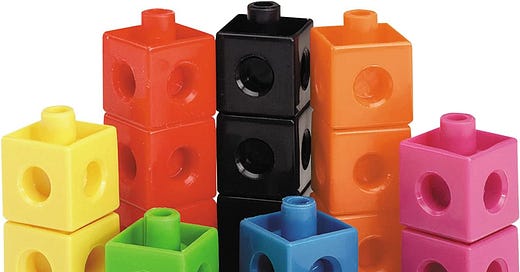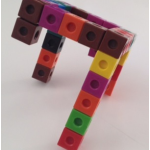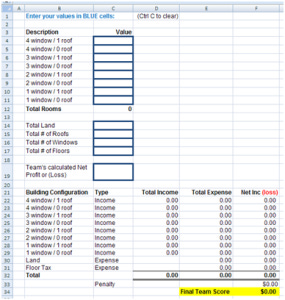[NCTM Illuminations has my full blessings and thanks to re-write and feature this lesson on their site.]
Andrew Stadel and I recently presented this task at the 2013 CMC North and South Conferences.
The Challenge
As a team, build a hotel using 50 cubes that yields the highest profit.
Rules and Guidelines
Each cube = one hotel room.
You must use all 50 cubes.
The hotel must stand freely—no leaning against anything. Here’s a non-example.
It must be one solid structure—no disconnected pieces.
Every room must have at least one window (a window = any exposed vertical face). The white cube has no window.
Costs (Daily Rates)
Land: $400 per square unit
Based on top-down view (the footprint).
Even enclosed “courtyards” with no outside access are charged.
Roof: $10 each (exposed top face)
Window: $5 each (exposed vertical face)
Height Tax: Tax rate depends on tallest floor:
Floors 1–10: 50% of land cost
Floors 11–20: 1000%
Floors 21–30: 2000%
Floors 31–40: 3000%
Floors 41–50: 5000%
Income (Daily Rates per Room)
The more windows, the more income:
4 windows, 1 roof = $600
4 windows, 0 roof = $500
3 windows, 1 roof = $300
3 windows, 0 roof = $250
2 windows, 1 roof = $200
2 windows, 0 roof = $175
1 window, 1 roof = $150
1 window, 0 roof = $125
Scoring
Net profit is checked for accuracy:
If your team’s reported profit differs from actual profit, you’re penalized 50% of the error.
For example: If you claim $15,000 but actual is $13,500, you're off by $1,500 → $750 is deducted → final score is $12,750.
Perfectly accurate profit earns a $1,000 bonus.
Adaptations
Use fewer cubes (10–15) for younger kids, more (up to 100) for high school.
For younger students: Have a pre-made spreadsheet where they can plug in values—no calculations needed.
Older students can build their own spreadsheets, practicing formulas and structure.
Change:
Costs, incomes, tax rates.
Group sizes.
Accuracy penalties.
How teams are formed or scored.
Extensions:
Estimate and rank other groups' hotels based on likely profit.
What if incomes were reversed (e.g., 1-window rooms earn most)? How would you redesign?
My 6th Grade Plan
We’d first build the same 10-cube hotel together to get familiar with windows, roofs, and tallying room types. Then practice calculating profit.
How I Ran It with My 8th Graders
Two classes (Geometry & Algebra), 57-minute periods. It took 2.5 class periods total.
Introduce the challenge + rules
Hand out 50 cubes in zip bags (show how to return them neatly!)
Hand out a cost/income sheet
Set a 15-minute timer for individual hotel building
Create random groups of 3 students.
Group Work (25 minutes)
Instructions to students:
Share your hotel ideas.
Choose one or start fresh.
Use a tally sheet to count room types, land area, roofs, etc.
Use the whiteboard, divided into 4 quadrants. Each group must fill 3 of the 4 now.
One tally sheet per group.
Monitor groups and count down every 5 minutes. When time is up, unselected hotel models get dismantled and cubes returned.
Day 2: Finalizing + What-Ifs
Groups retrieve their chosen hotel and whiteboard.
Final question (Quadrant 4): If you could relocate 5 cubes, where would they go?
They can’t actually change the hotel, just theorize.
Groups finish tally sheets, answer all 4 quadrant questions.
Bring tally sheets to teacher for score check.
The Spreadsheet
I use two versions (please contact me for these):
Locked: Only blue input cells are editable—great for student use.
Unlocked: For teacher editing.
It’s aligned with the tally sheet for quick data entry and instant results.
Reflections
This lesson just worked. Students were all in. Tons of conversation and collaboration. Silence during individual work time. Beautiful variety in hotel designs—same with the teachers who tried it!
To avoid spoilers, I won’t post pictures of top-scoring hotels. But if you try it, I’d love to hear what kinds of profits your students were able to generate.












